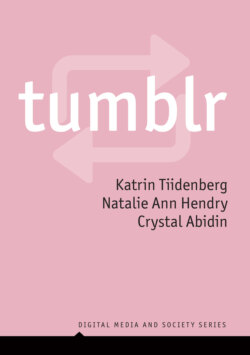Читать книгу Tumblr - Tama Leaver, Crystal Abidin - Страница 19
Setting up and posting
ОглавлениеSetting up a tumblr account is easy: users only need to provide a functioning email address and state their age and, voilà, they have a blog. Tumblr Inc.’s designers and engineers try to help new users find “what’re you into” (see Chapter 2) during the onboarding process. This directs users to curate their own blogs as interest-based spaces too. The blogs are not profiles, and whether any particular blog has a description at all depends on the chosen blog “theme”; these are available for free and for purchase in the tumblr “themes” catalogue. Further, those descriptions are completely open, filled out with any information that users deem relevant (see Oakely 2016 on self-labeling in About sections). After setting up one blog, users can set up as many “secondary” or “side” blogs as they want and toggle between their blogs from the same user interface. While only “primary” or “main” blogs (created upon account sign-up) have social features that allow following others, liking, and replying to posts, secondary blogs can be set to be private- and password-protected. A user cannot change a previously primary blog to private, or a previously secondary blog to primary (something often highlighted as a fault by users), so it is quite common for users to set up more than one primary account. Users with multiple (primary or secondary) blogs generally argue that this allows for multifaceted self-presentation, audience segregation, and identity curation.
Types of blog posts invited via specific buttons are text posts, photo posts, quote posts, link posts, chat posts, and audio or video posts (see Figure 1.1 for tumblr’s dashboard on a desktop). Visual content, in particular photos, is very popular (78.11 percent of posts in Chang et al. 2014). While most social media platforms allow sharing texts, links, and visual content, the tumblr “chat” post format is less common. Linguists Camilla Vásquez and Samantha Creel (2017) link the popularization of chat memes, especially the me-chat meme, across social media directly to this tumblr feature. Me-chat memes usually feature a pretend conversation between various facets of one’s identity, like “past me” and “present me,” or just two “me”s with incompatible goals and desires, usually to a humorous or relatable effect (see Chapter 7).
Figure 1.1: Artist’s impression of the changing interface design of tumblr’s dashboard. left: 2007; right: current browser dashboard at the time of writing in 2020. Art provided by River Juno.
While different types of posts continue to be differentiated and the “chat” post was still available via the browser-based Dashboard in 2020, the mobile interface has recently been updated to significantly alter the posting experience (Figure 1.2). The post icon looks like a pen, which feels less multimodal and more writing-centric and “bloglike.” This possibly follows Automattic’s acquisition, as the company is best known for the legendary blogging platform WordPress. Clicking on the pen icon gives further options of taking an image, uploading image or video from the camera roll, adding a link, making or choosing a GIF, choosing an audio file from Spotify or Soundcloud, and adding hashtags. However, the experience of tumblr is not just about posting but, more importantly, about consuming what other people have posted.
Figure 1.2: Artist’s impression of the tumblr interface via the app on a mobile phone. Art provided by River Juno.
